Abstract
The composition of lipoproteins in the plasma of patients with LCAT deficiency (LCAT-D) is grossly altered due to the lack of cholesteryl esters which form the core of normal lipoproteins. When plasma from LCAT-D patients and their relatives was examined we found that nine heterozygotes had plasma Lp(a) levels of 2-13 mg/dl whereas none of 11 affected homozygous individuals from different families contained detectable amounts of Lp(a) in their plasma. Therefore, the binding of apo(a) to LDL density particles was studied in vitro using LDL density fractions prepared from patients, and recombinant apo(a) [r-apo(a)], which was expressed and secreted by transfected COS-7 cells. The LDL from heterozygotes were chemically indistinguishable from normal LDL and homogeneous with regard to morphology, whereas the crude LDL floating fraction from homozygotes consisted of a heterogeneous mixture of large vesicles, and small spheres resembling normal LDL. The LDL density fraction from the LCAT-D patient lacked almost completely cholesteryl esters. Incubation of LCAT-D plasma with active LCAT caused a substantial augmentation of the original subfraction which morphologically resembled normal LDL. Using r-apo(a) and normal LDL or LDL of heterozygous individuals, apoB:r-apo(a) complexes were formed when incubated at 37 degrees C in vitro for 20 h. In contrast, the total LDL floating fraction from a homozygous LCAT-D patient failed to form apoB:r-apo(a) complexes. After treatment with active LCAT, a significant apoB:r-apo(a) association was observed with LCAT-D LDL-density particles. Our data emphasize the importance of the integrity of LDL structure and composition for the formation of Lp(a). In addition, we demonstrate that the absence of LCAT activity has a fundamental impact on the regulation of plasma Lp(a) levels.
Full text
PDF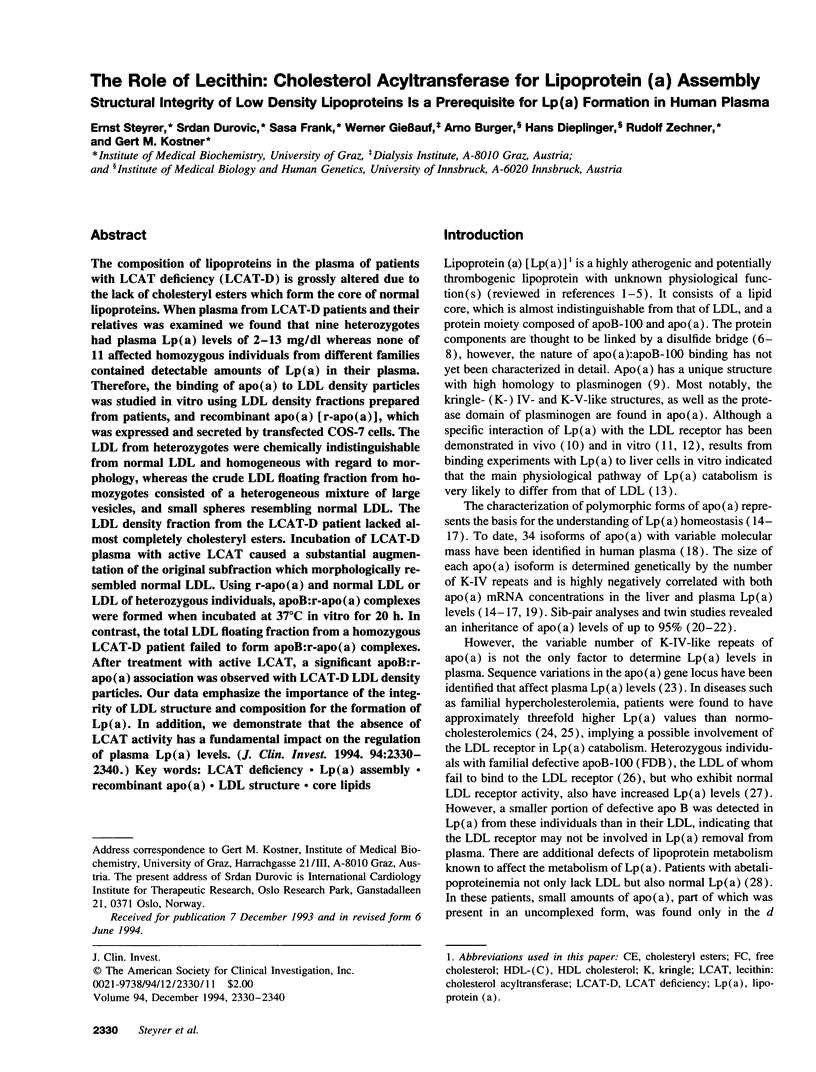
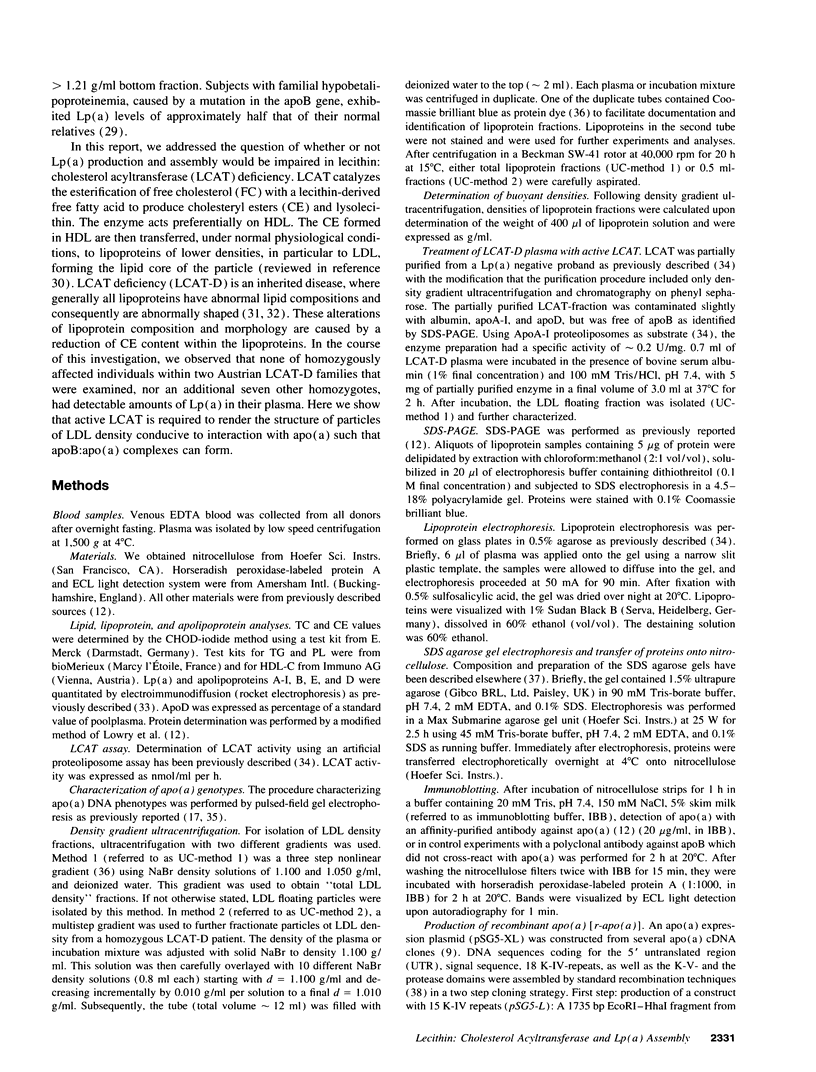
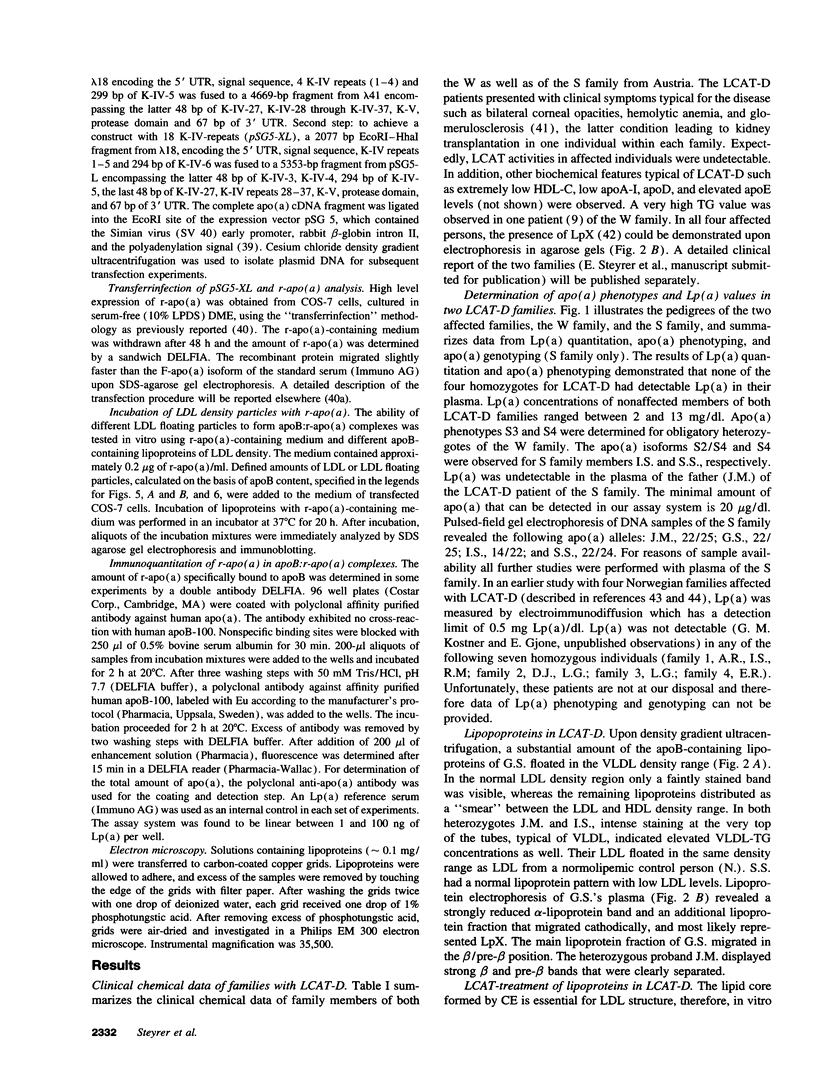
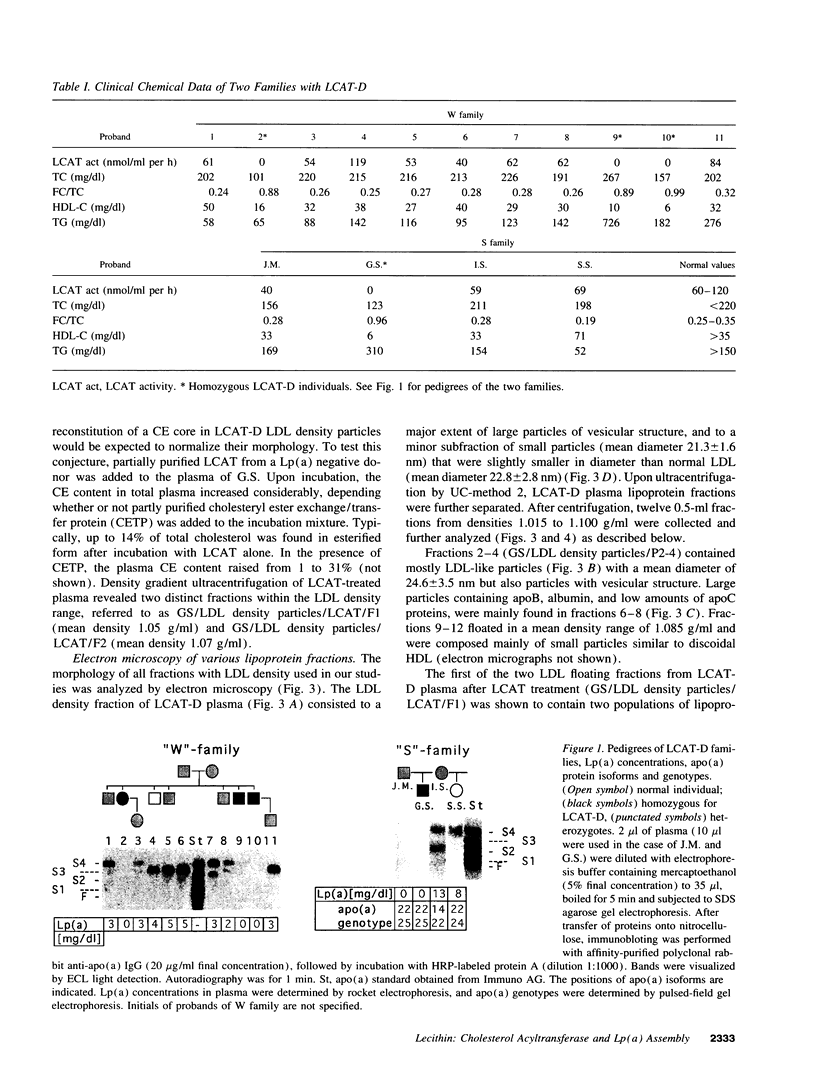
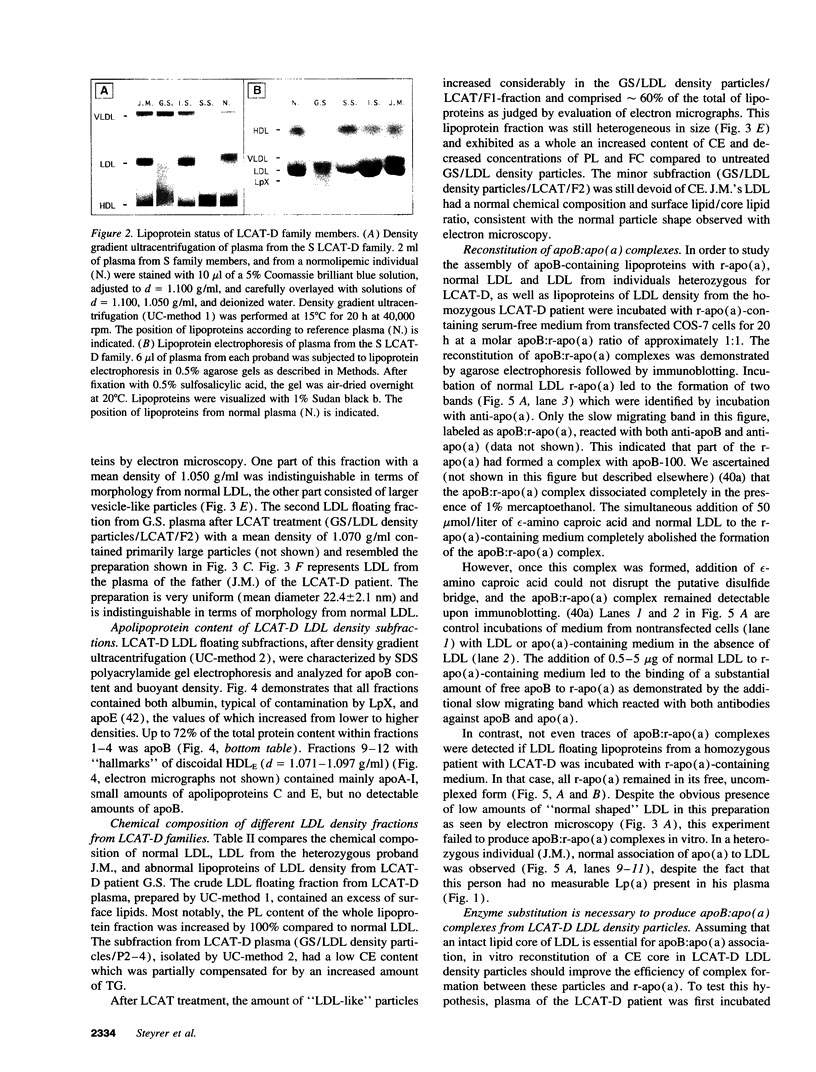
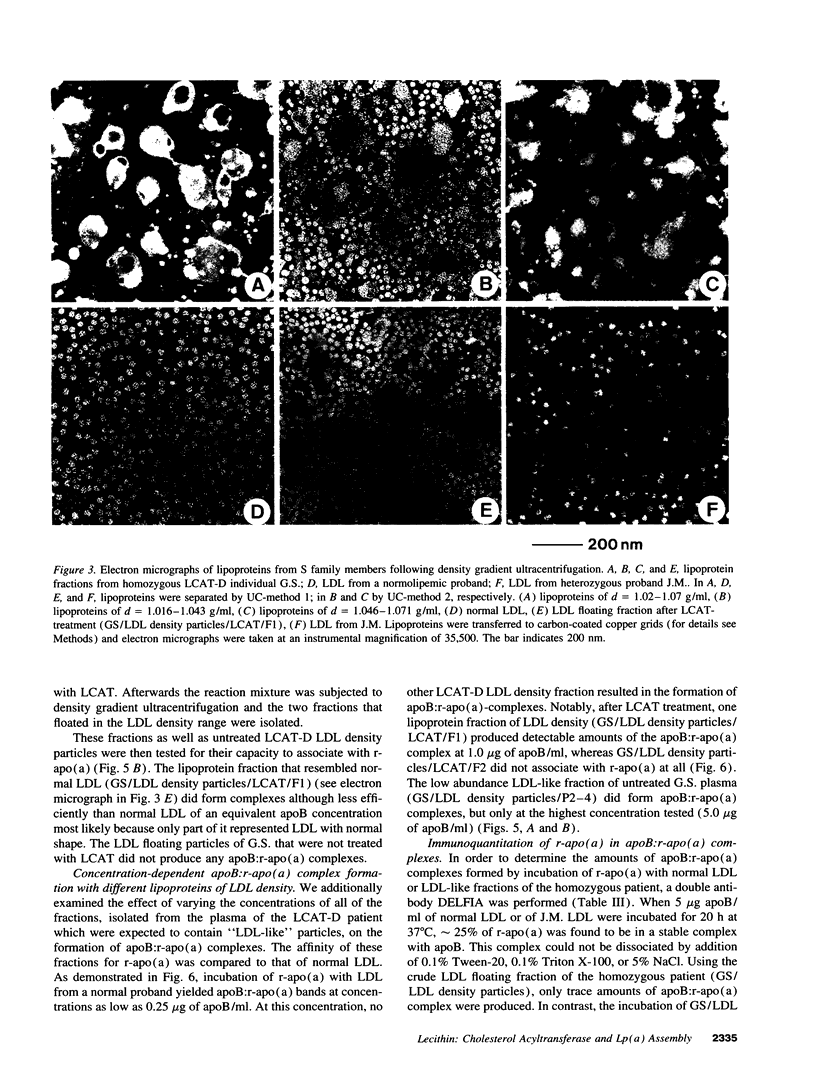
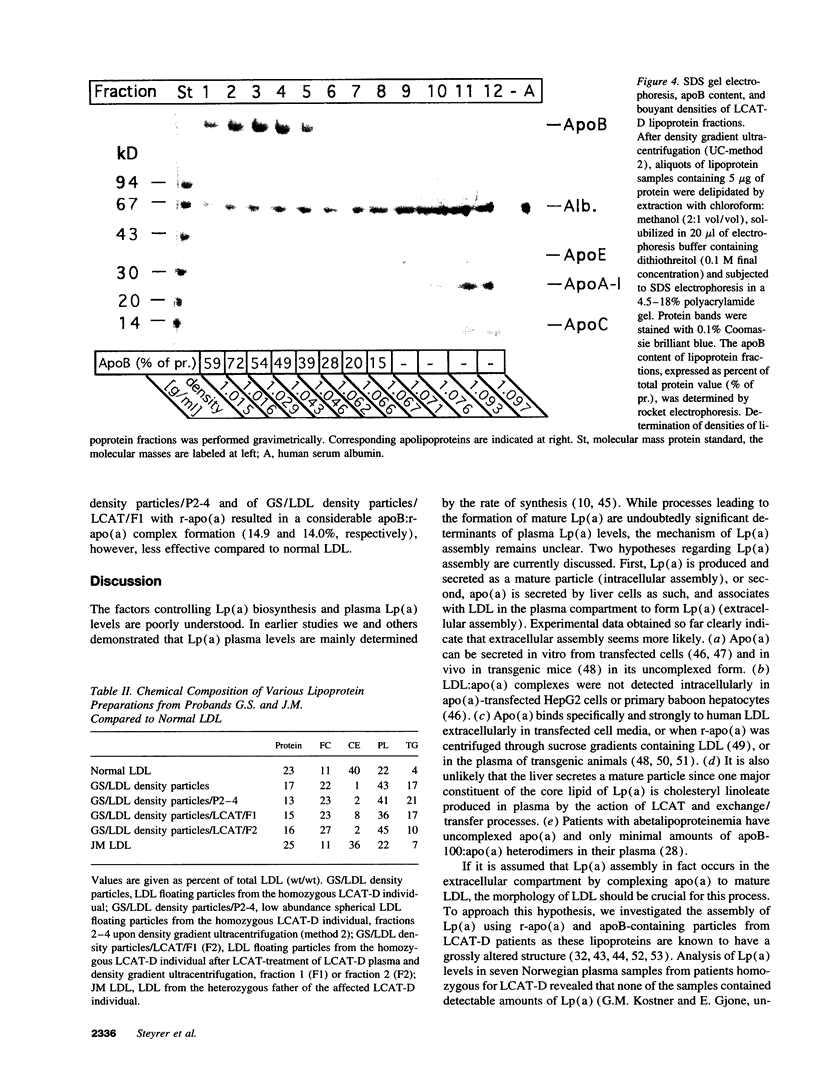
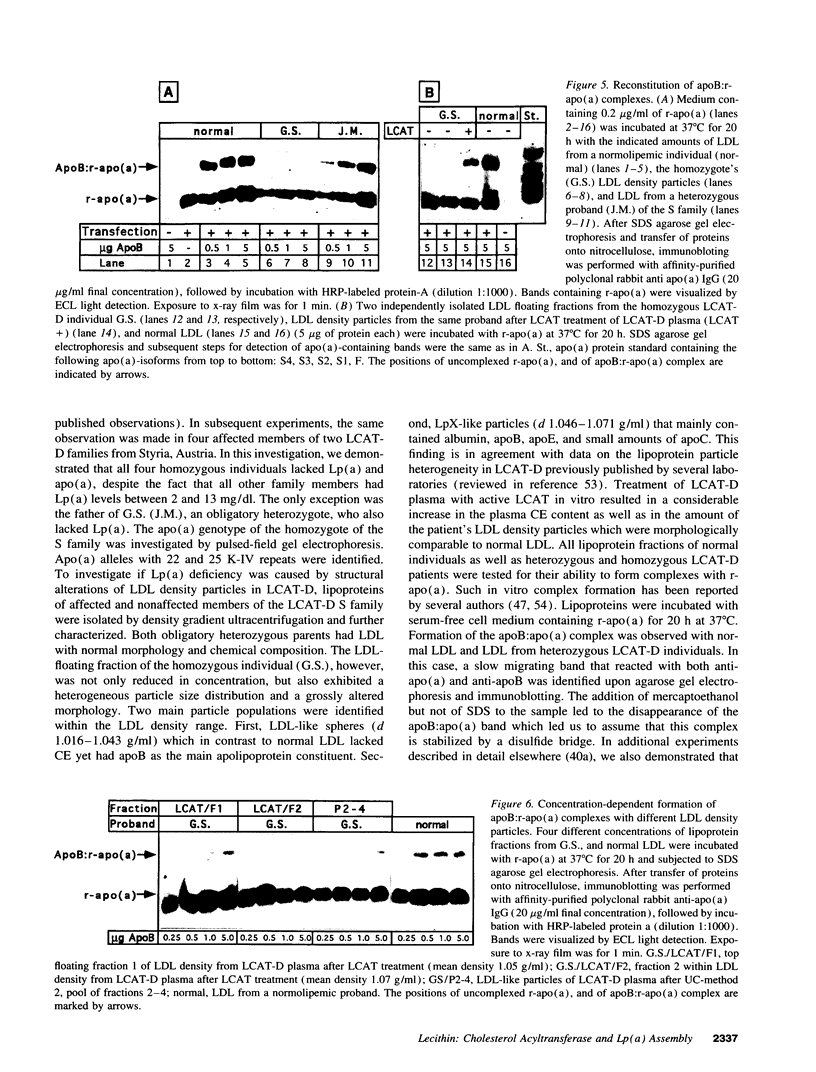
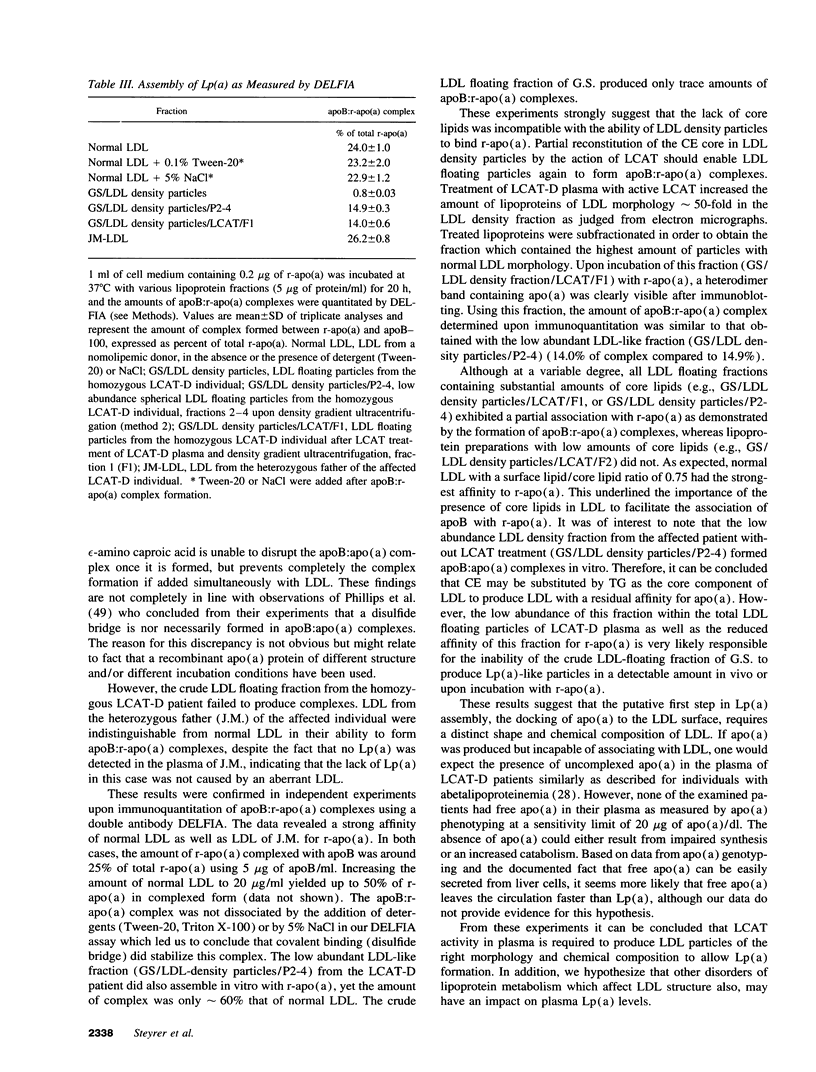
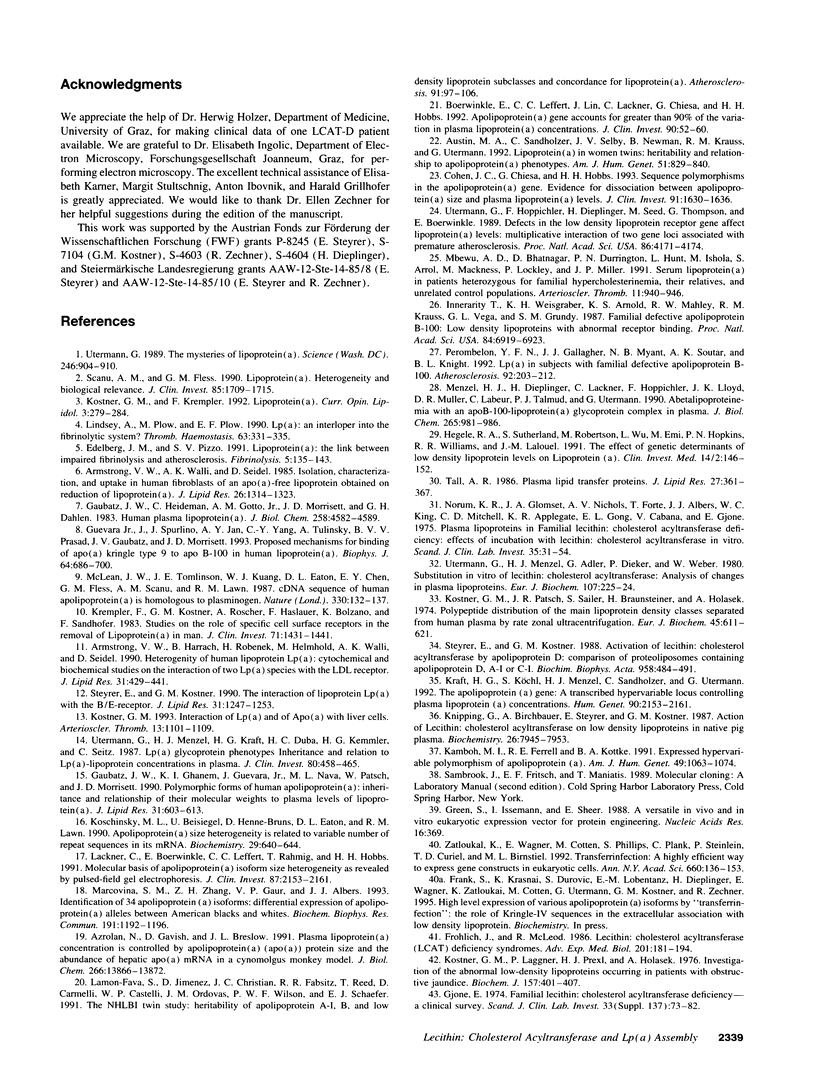
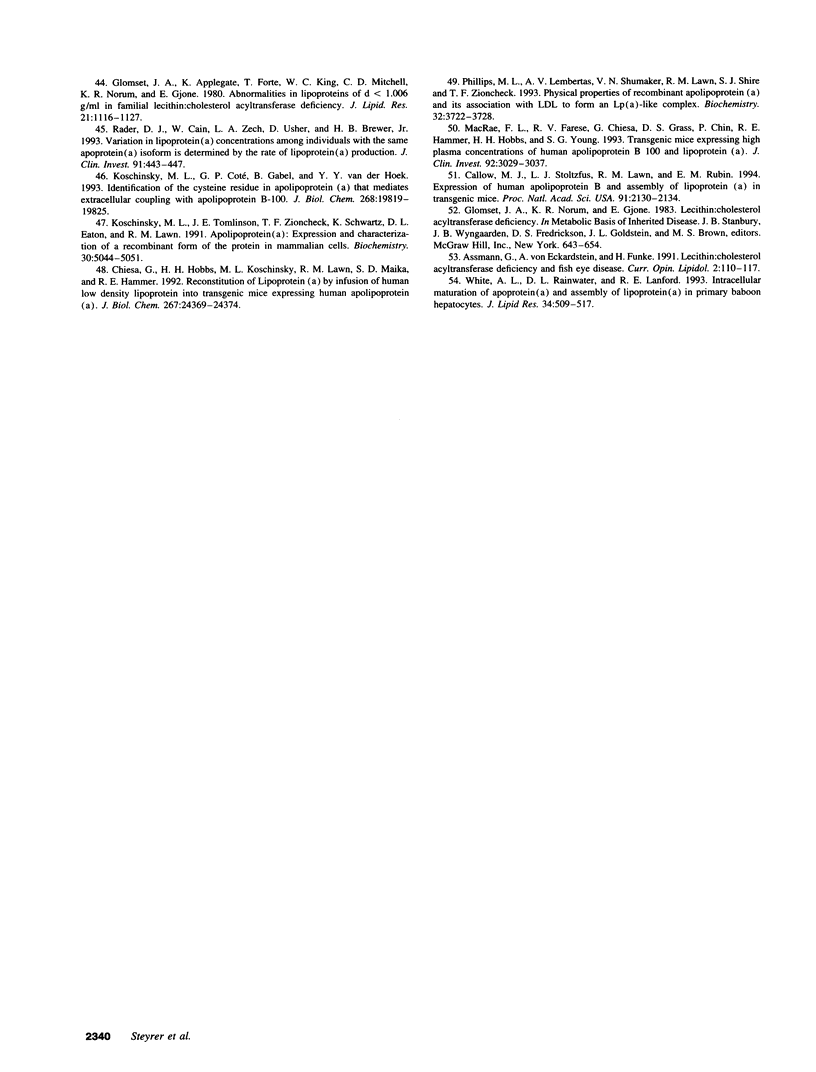
Images in this article
Selected References
These references are in PubMed. This may not be the complete list of references from this article.
- Armstrong V. W., Harrach B., Robenek H., Helmhold M., Walli A. K., Seidel D. Heterogeneity of human lipoprotein Lp[a]: cytochemical and biochemical studies on the interaction of two Lp[a] species with the LDL receptor. J Lipid Res. 1990 Mar;31(3):429–441. [PubMed] [Google Scholar]
- Armstrong V. W., Walli A. K., Seidel D. Isolation, characterization, and uptake in human fibroblasts of an apo(a)-free lipoprotein obtained on reduction of lipoprotein(a). J Lipid Res. 1985 Nov;26(11):1314–1323. [PubMed] [Google Scholar]
- Austin M. A., Sandholzer C., Selby J. V., Newman B., Krauss R. M., Utermann G. Lipoprotein(a) in women twins: heritability and relationship to apolipoprotein(a) phenotypes. Am J Hum Genet. 1992 Oct;51(4):829–840. [PMC free article] [PubMed] [Google Scholar]
- Azrolan N., Gavish D., Breslow J. L. Plasma lipoprotein(a) concentration is controlled by apolipoprotein(a) (apo(a)) protein size and the abundance of hepatic apo(a) mRNA in a cynomolgus monkey model. J Biol Chem. 1991 Jul 25;266(21):13866–13872. [PubMed] [Google Scholar]
- Boerwinkle E., Leffert C. C., Lin J., Lackner C., Chiesa G., Hobbs H. H. Apolipoprotein(a) gene accounts for greater than 90% of the variation in plasma lipoprotein(a) concentrations. J Clin Invest. 1992 Jul;90(1):52–60. doi: 10.1172/JCI115855. [DOI] [PMC free article] [PubMed] [Google Scholar]
- Callow M. J., Stoltzfus L. J., Lawn R. M., Rubin E. M. Expression of human apolipoprotein B and assembly of lipoprotein(a) in transgenic mice. Proc Natl Acad Sci U S A. 1994 Mar 15;91(6):2130–2134. doi: 10.1073/pnas.91.6.2130. [DOI] [PMC free article] [PubMed] [Google Scholar]
- Chiesa G., Hobbs H. H., Koschinsky M. L., Lawn R. M., Maika S. D., Hammer R. E. Reconstitution of lipoprotein(a) by infusion of human low density lipoprotein into transgenic mice expressing human apolipoprotein(a). J Biol Chem. 1992 Dec 5;267(34):24369–24374. [PubMed] [Google Scholar]
- Cohen J. C., Chiesa G., Hobbs H. H. Sequence polymorphisms in the apolipoprotein (a) gene. Evidence for dissociation between apolipoprotein(a) size and plasma lipoprotein(a) levels. J Clin Invest. 1993 Apr;91(4):1630–1636. doi: 10.1172/JCI116370. [DOI] [PMC free article] [PubMed] [Google Scholar]
- Frohlich J., McLeod R. Lecithin: cholesterol acyltransferase (LCAT) deficiency syndromes. Adv Exp Med Biol. 1986;201:181–194. doi: 10.1007/978-1-4684-1262-8_16. [DOI] [PubMed] [Google Scholar]
- Gaubatz J. W., Ghanem K. I., Guevara J., Jr, Nava M. L., Patsch W., Morrisett J. D. Polymorphic forms of human apolipoprotein[a]: inheritance and relationship of their molecular weights to plasma levels of lipoprotein[a]. J Lipid Res. 1990 Apr;31(4):603–613. [PubMed] [Google Scholar]
- Gaubatz J. W., Heideman C., Gotto A. M., Jr, Morrisett J. D., Dahlen G. H. Human plasma lipoprotein [a]. Structural properties. J Biol Chem. 1983 Apr 10;258(7):4582–4589. [PubMed] [Google Scholar]
- Gjone E. Familial lecithin:cholesterol acyltransferase deficiency--a clinical survey. Scand J Clin Lab Invest Suppl. 1974;137:73–82. [PubMed] [Google Scholar]
- Glomset J. A., Applegate K., Forte T., King W. C., Mitchell C. D., Norum K. R., Gjone E. Abnormalities in lipoproteins of d < 1.006 g/ml in familial lecithin:cholesterol acyltransferase deficiency. J Lipid Res. 1980 Nov;21(8):1116–1127. [PubMed] [Google Scholar]
- Green S., Issemann I., Sheer E. A versatile in vivo and in vitro eukaryotic expression vector for protein engineering. Nucleic Acids Res. 1988 Jan 11;16(1):369–369. doi: 10.1093/nar/16.1.369. [DOI] [PMC free article] [PubMed] [Google Scholar]
- Guevara J., Jr, Spurlino J., Jan A. Y., Yang C. Y., Tulinsky A., Prasad B. V., Gaubatz J. W., Morrisett J. D. Proposed mechanisms for binding of apo[a] kringle type 9 to apo B-100 in human lipoprotein[a]. Biophys J. 1993 Mar;64(3):686–700. doi: 10.1016/S0006-3495(93)81428-0. [DOI] [PMC free article] [PubMed] [Google Scholar]
- Hegele R. A., Sutherland S., Robertson M., Wu L., Emi M., Hopkins P. N., Williams R. R., Lalouel J. M. The effect of genetic determinants of low density lipoprotein levels on lipoprotein (a). Clin Invest Med. 1991 Apr;14(2):146–152. [PubMed] [Google Scholar]
- Innerarity T. L., Weisgraber K. H., Arnold K. S., Mahley R. W., Krauss R. M., Vega G. L., Grundy S. M. Familial defective apolipoprotein B-100: low density lipoproteins with abnormal receptor binding. Proc Natl Acad Sci U S A. 1987 Oct;84(19):6919–6923. doi: 10.1073/pnas.84.19.6919. [DOI] [PMC free article] [PubMed] [Google Scholar]
- Kamboh M. I., Ferrell R. E., Kottke B. A. Expressed hypervariable polymorphism of apolipoprotein (a). Am J Hum Genet. 1991 Nov;49(5):1063–1074. [PMC free article] [PubMed] [Google Scholar]
- Knipping G., Birchbauer A., Steyrer E., Kostner G. M. Action of lecithin-cholesterol acyltransferase on low-density lipoproteins in native pig plasma. Biochemistry. 1987 Dec 1;26(24):7945–7953. doi: 10.1021/bi00398a060. [DOI] [PubMed] [Google Scholar]
- Koschinsky M. L., Beisiegel U., Henne-Bruns D., Eaton D. L., Lawn R. M. Apolipoprotein(a) size heterogeneity is related to variable number of repeat sequences in its mRNA. Biochemistry. 1990 Jan 23;29(3):640–644. doi: 10.1021/bi00455a007. [DOI] [PubMed] [Google Scholar]
- Koschinsky M. L., Côté G. P., Gabel B., van der Hoek Y. Y. Identification of the cysteine residue in apolipoprotein(a) that mediates extracellular coupling with apolipoprotein B-100. J Biol Chem. 1993 Sep 15;268(26):19819–19825. [PubMed] [Google Scholar]
- Koschinsky M. L., Tomlinson J. E., Zioncheck T. F., Schwartz K., Eaton D. L., Lawn R. M. Apolipoprotein(a): expression and characterization of a recombinant form of the protein in mammalian cells. Biochemistry. 1991 May 21;30(20):5044–5051. doi: 10.1021/bi00234a029. [DOI] [PubMed] [Google Scholar]
- Kostner G. M. Interaction of Lp(a) and of apo(a) with liver cells. Arterioscler Thromb. 1993 Jul;13(7):1101–1109. doi: 10.1161/01.atv.13.7.1101. [DOI] [PubMed] [Google Scholar]
- Kostner G. M., Laggner P., Prexl H. J., Holasek A. Investigation of the abnormal low-density lipoproteins occurring in patients with obstructive jaundice. Biochem J. 1976 Aug 1;157(2):401–407. doi: 10.1042/bj1570401. [DOI] [PMC free article] [PubMed] [Google Scholar]
- Kostner G. M., Patsch J. R., Sailer S., Braunsteiner H., Holasek A. Polypeptide distribution of the main lipoprotein density classes separated from human plasma by rate zonal ultracentrifugation. Eur J Biochem. 1974 Jun 15;45(2):611–621. doi: 10.1111/j.1432-1033.1974.tb03587.x. [DOI] [PubMed] [Google Scholar]
- Krempler F., Kostner G. M., Roscher A., Haslauer F., Bolzano K., Sandhofer F. Studies on the role of specific cell surface receptors in the removal of lipoprotein (a) in man. J Clin Invest. 1983 May;71(5):1431–1441. doi: 10.1172/JCI110896. [DOI] [PMC free article] [PubMed] [Google Scholar]
- Lackner C., Boerwinkle E., Leffert C. C., Rahmig T., Hobbs H. H. Molecular basis of apolipoprotein (a) isoform size heterogeneity as revealed by pulsed-field gel electrophoresis. J Clin Invest. 1991 Jun;87(6):2153–2161. doi: 10.1172/JCI115248. [DOI] [PMC free article] [PubMed] [Google Scholar]
- Lamon-Fava S., Jimenez D., Christian J. C., Fabsitz R. R., Reed T., Carmelli D., Castelli W. P., Ordovas J. M., Wilson P. W., Schaefer E. J. The NHLBI Twin Study: heritability of apolipoprotein A-I, B, and low density lipoprotein subclasses and concordance for lipoprotein(a). Atherosclerosis. 1991 Nov;91(1-2):97–106. doi: 10.1016/0021-9150(91)90191-5. [DOI] [PubMed] [Google Scholar]
- Linton M. F., Farese R. V., Jr, Chiesa G., Grass D. S., Chin P., Hammer R. E., Hobbs H. H., Young S. G. Transgenic mice expressing high plasma concentrations of human apolipoprotein B100 and lipoprotein(a). J Clin Invest. 1993 Dec;92(6):3029–3037. doi: 10.1172/JCI116927. [DOI] [PMC free article] [PubMed] [Google Scholar]
- Marcovina S. M., Zhang Z. H., Gaur V. P., Albers J. J. Identification of 34 apolipoprotein(a) isoforms: differential expression of apolipoprotein(a) alleles between American blacks and whites. Biochem Biophys Res Commun. 1993 Mar 31;191(3):1192–1196. doi: 10.1006/bbrc.1993.1343. [DOI] [PubMed] [Google Scholar]
- Mbewu A. D., Bhatnagar D., Durrington P. N., Hunt L., Ishola M., Arrol S., Mackness M., Lockley P., Miller J. P. Serum lipoprotein(a) in patients heterozygous for familial hypercholesterolemia, their relatives, and unrelated control populations. Arterioscler Thromb. 1991 Jul-Aug;11(4):940–946. doi: 10.1161/01.atv.11.4.940. [DOI] [PubMed] [Google Scholar]
- McLean J. W., Tomlinson J. E., Kuang W. J., Eaton D. L., Chen E. Y., Fless G. M., Scanu A. M., Lawn R. M. cDNA sequence of human apolipoprotein(a) is homologous to plasminogen. Nature. 1987 Nov 12;330(6144):132–137. doi: 10.1038/330132a0. [DOI] [PubMed] [Google Scholar]
- Menzel H. J., Dieplinger H., Lackner C., Hoppichler F., Lloyd J. K., Muller D. R., Labeur C., Talmud P. J., Utermann G. Abetalipoproteinemia with an ApoB-100-lipoprotein(a) glycoprotein complex in plasma. Indication for an assembly defect. J Biol Chem. 1990 Jan 15;265(2):981–986. [PubMed] [Google Scholar]
- Miles L. A., Plow E. F. Lp(a): an interloper into the fibrinolytic system? Thromb Haemost. 1990 Jun 28;63(3):331–335. [PubMed] [Google Scholar]
- Norum K. R., Glomset J. A., Nichols A. V., Forte T., Albers J. J., King W. C., Mitchell C. D., Applegate K. R., Gong E. L., Cabana V. Plasma lipoproteins in familial lecithin: cholesterol acyltransferase deficiency: effects of incubation with lecithin: cholesterol acyltransferase in vitro. Scand J Clin Lab Invest Suppl. 1975;142:31–55. [PubMed] [Google Scholar]
- Perombelon Y. F., Gallagher J. J., Myant N. B., Soutar A. K., Knight B. L. Lipoprotein(a) in subjects with familial defective apolipoprotein B100. Atherosclerosis. 1992 Feb;92(2-3):203–212. doi: 10.1016/0021-9150(92)90279-p. [DOI] [PubMed] [Google Scholar]
- Phillips M. L., Lembertas A. V., Schumaker V. N., Lawn R. M., Shire S. J., Zioncheck T. F. Physical properties of recombinant apolipoprotein(a) and its association with LDL to form an LP(a)-like complex. Biochemistry. 1993 Apr 13;32(14):3722–3728. doi: 10.1021/bi00065a026. [DOI] [PubMed] [Google Scholar]
- Rader D. J., Cain W., Zech L. A., Usher D., Brewer H. B., Jr Variation in lipoprotein(a) concentrations among individuals with the same apolipoprotein (a) isoform is determined by the rate of lipoprotein(a) production. J Clin Invest. 1993 Feb;91(2):443–447. doi: 10.1172/JCI116221. [DOI] [PMC free article] [PubMed] [Google Scholar]
- Scanu A. M., Fless G. M. Lipoprotein (a). Heterogeneity and biological relevance. J Clin Invest. 1990 Jun;85(6):1709–1715. doi: 10.1172/JCI114625. [DOI] [PMC free article] [PubMed] [Google Scholar]
- Steyrer E., Kostner G. M. Activation of lecithin-cholesterol acyltransferase by apolipoprotein D: comparison of proteoliposomes containing apolipoprotein D, A-I or C-I. Biochim Biophys Acta. 1988 Feb 19;958(3):484–491. doi: 10.1016/0005-2760(88)90235-4. [DOI] [PubMed] [Google Scholar]
- Steyrer E., Kostner G. M. Interaction of lipoprotein Lp[a] with the B/E-receptor: a study using isolated bovine adrenal cortex and human fibroblast receptors. J Lipid Res. 1990 Jul;31(7):1247–1253. [PubMed] [Google Scholar]
- Tall A. R. Plasma lipid transfer proteins. J Lipid Res. 1986 Apr;27(4):361–367. [PubMed] [Google Scholar]
- Utermann G., Hoppichler F., Dieplinger H., Seed M., Thompson G., Boerwinkle E. Defects in the low density lipoprotein receptor gene affect lipoprotein (a) levels: multiplicative interaction of two gene loci associated with premature atherosclerosis. Proc Natl Acad Sci U S A. 1989 Jun;86(11):4171–4174. doi: 10.1073/pnas.86.11.4171. [DOI] [PMC free article] [PubMed] [Google Scholar]
- Utermann G., Menzel H. J., Adler G., Dieker P., Weber W. Substitution in vitro of lecithin-cholesterol acyltransferase. Analysis of changes in plasma lipoproteins. Eur J Biochem. 1980;107(1):225–241. doi: 10.1111/j.1432-1033.1980.tb04643.x. [DOI] [PubMed] [Google Scholar]
- Utermann G., Menzel H. J., Kraft H. G., Duba H. C., Kemmler H. G., Seitz C. Lp(a) glycoprotein phenotypes. Inheritance and relation to Lp(a)-lipoprotein concentrations in plasma. J Clin Invest. 1987 Aug;80(2):458–465. doi: 10.1172/JCI113093. [DOI] [PMC free article] [PubMed] [Google Scholar]
- Utermann G. The mysteries of lipoprotein(a). Science. 1989 Nov 17;246(4932):904–910. doi: 10.1126/science.2530631. [DOI] [PubMed] [Google Scholar]
- White A. L., Rainwater D. L., Lanford R. E. Intracellular maturation of apolipoprotein[a] and assembly of lipoprotein[a] in primary baboon hepatocytes. J Lipid Res. 1993 Mar;34(3):509–517. [PubMed] [Google Scholar]
- Zatloukal K., Wagner E., Cotten M., Phillips S., Plank C., Steinlein P., Curiel D. T., Birnstiel M. L. Transferrinfection: a highly efficient way to express gene constructs in eukaryotic cells. Ann N Y Acad Sci. 1992 Oct 28;660:136–153. doi: 10.1111/j.1749-6632.1992.tb21066.x. [DOI] [PubMed] [Google Scholar]








